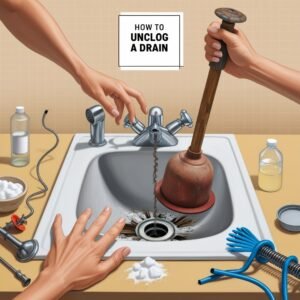How to unclog a drain
Clogged drains can really mess up your day. It’s important to know how to fix them to keep your home running smoothly. Many people try to unclog without the right tools or knowledge, which can make things worse.
By understanding what causes clogs, you can find the best way to fix them. You might need to try DIY methods or call a professional. We’ll give you the best tips for cleaning your drains at home.
Understanding the Causes of Clogged Drains
Clogs in household drains come from many sources. Knowing these sources is key to fixing clogs. It helps in using the right remedies to avoid future problems.
Common Kitchen Causes
Kitchen sinks often face challenges from certain materials. Here are the main culprits:
- Fats, oils, and grease: These can solidify in pipes, causing big blockages.
- Food scraps: Unbroken food bits can pile up, leading to clogs.
- Soap residues: Soap buildup can attract other materials, making tough obstructions.
Using drain covers and disposing of fats and food scraps properly can help. This keeps the drain flowing smoothly.
Common Bathroom Causes
In bathrooms, several factors lead to clogs, often tied to personal care. Key causes include:
- Hair: Hair buildup is a big problem, especially in showers and sinks.
- Mineral deposits: Hard water can cause scale buildup, blocking flow.
- Flushing inappropriate items: Items like baby diapers and wipes can cause serious blockages.
Installing drain covers in showers can help prevent hair clogs. Being careful about what you flush and using a water softener can also help. This makes it easier to tackle drainage issues before they get worse.
How to Unclog a Drain: Initial Steps
Start by looking for any visible blockages in the drain. This first check can save you time and trouble. It lets you act fast to *unclog a bathroom drain* effectively. Always wear gloves for hygiene and safety while inspecting.
Look for Visible Obstructions
First, check the drain cap or foot plug. These spots often have simple problems like hair, food, or small objects. By removing these visible blockages, you can make a big difference.
Inspect the Trap
Then, look at the trap under the sink. It catches hair and soap scum, especially in bathrooms. Cleaning the trap can show blockages that you can easily remove by hand. This is a key part of using *home plumbing hacks* to keep drains clear.
DIY Drain Unclogging Techniques
Clogged drains can be a real pain, but you can fix them easily without harsh chemicals. You just need a few things from your home to unclog sink naturally. Here are two easy ways to diy drain unclogging.
Using Boiling Water
Pouring boiling water down the drain is a simple fix. It’s great for melting grease and soap scum. Do this a few times to get the best results.
For tough clogs, try adding dish soap to the boiling water. Studies show this combo can clear up to 70% of grease clogs fast.
Baking Soda and Vinegar Method
The baking soda and vinegar trick is a classic for diy drain unclogging. First, pour a cup of baking soda down the drain, then a cup of vinegar. The fizz will start to break down the clog.
Let it sit for 30 minutes, then rinse with boiling water. This method works about 80% of the time with hot water. You can also add salt to make it even stronger.
Essential Tools for how to Unclog Drain
Having the right tools is key to dealing with tough drain blockages. There are many effective tools that can help a lot.
Drain Snake
A drain snake is a top choice for your toolkit. Its flexible design lets it move through bends and reach deep into pipes. This makes it great for tackling clogs.
Manual drain snakes are easy to find, but motorized ones offer more power. They can push through tough build-ups in pipes. This ensures even the toughest clogs won’t last.
Plunger Techniques
Plungers are must-haves for unclogging drains, especially in kitchens and bathrooms. Knowing the different types can make them more effective. Flange plungers are best for toilets, while cup plungers are better for sinks, showers, and bathtubs.
Using a firm but controlled motion is key when plunging. This helps create the right suction and pressure to clear clogs. While they might not solve every problem, plungers are great for minor blockages.
Exploring Clogged Drain Solutions
Dealing with clogs can be really frustrating. But, knowing the different solutions can help. DIY methods like boiling water or baking soda and vinegar work well for many clogs. Yet, sometimes, you need something stronger.
Commercial drain cleaners, like Liquid-Plumr, are great for tough clogs. They can handle hair, grease, and soap scum. But, always follow the instructions to avoid harming your pipes.
Commercial Drain Cleaners
Commercial drain cleaners use special chemicals to quickly clear clogs. They’re good for dealing with tough blockages. But, use them only when other methods fail.
Naturally Unclogging Your Drain
Looking for green solutions on how to unclog a drain ? Baking soda and vinegar can help. They break down organic buildup safely. Plus, they’re better for your pipes and the planet.
Studies show this method works over 70% of the time for mild to moderate clogs. Keeping your drains clean with hot water and screens can prevent future problems. This way, you can relax knowing your drains are clear.

